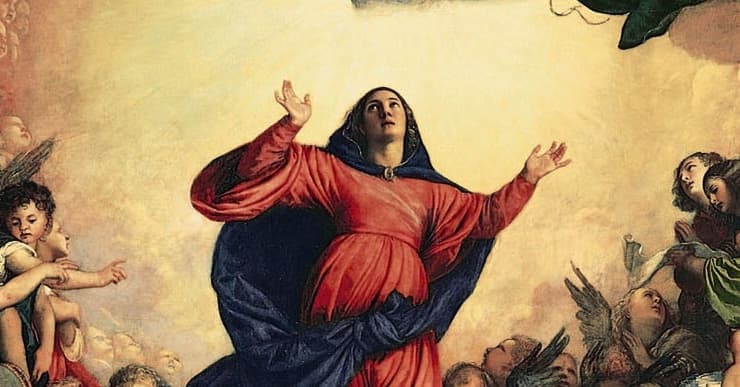The Assumption of Mary

There is oftentimes some confusion between the Ascension—when Jesus, by His own power, returned to heaven in glory 40 days after His Resurrection from the dead—and the Assumption which pertains to the end of His Mother’s earthly life. The Feast of the Assumption is when the Church celebrates the fact that the Blessed Virgin Mary, the Mother of God, was taken up into heaven by the power of God in both body and soul at the end of her earthly life.
This belief holds that after Jesus ascended into heaven, Mary continued to live for some years and supported the early Church through her prayers. When the time of her earthly life was finished, she was gloriously assumed into heaven in both body and soul. This doctrine has always been a part of the Church’s oral tradition, and Pope Pius XII officially defined the doctrine in 1950.
There is not a strict account of this event in Sacred Scripture, but the reason and argument for this event is contained within Scripture. In Luke 1:28, during the Annunciation when the angel Gabriel tells Mary that she is to become the Mother of God, he proclaims that Mary is “full of grace.” This fullness of grace points to the doctrine of the Immaculate Conception, meaning that Mary was conceived without sin. With the intention of preparing her to become the Mother of God, from the moment of her conception, God preserved Mary from the stain and effects of original sin. Due to her Immaculate Conception, she never committed a personal sin and she was free from the effects of original sin. Some of those effects include the decay of the body after death and the time of separation of the body and soul before they are reunited at the Last Judgement.
In addition to being free from sin, Mary is also the Mother of God. Through the Incarnation, Jesus’ body came into being through the gift of Mary’s flesh. From this, it follows that it is fitting that she should share in the fruits of the Redemption He won for us and in His bodily glorification before the general resurrection of the dead.
In keeping with Mary’s Immaculate Conception and role as the Mother of God, we as the Church believe that her body was preserved from the decay of death in the same way that her soul was preserved from the corruption of sin. We also believe that she did not suffer a prolonged separation of her body from her soul at the end of her earthly life, but rather her body was brought straight to heaven with her soul.
The Church celebrates the feast of the Assumption of the Blessed Virgin Mary on August 15, and it is a holy day of obligation. This means that the faithful are required to attend mass on that day in honor of the feast.
The truth of Mary’s Assumption is more than simply a fun fact about her life. We celebrate the Assumption to honor Mary, but we also celebrate it as a sign of our hope in our own bodily resurrection from the dead. The Blessed Virgin Mary is a fully human person who through the merits of our Savior Jesus Christ was fully conformed to Him and is now enjoying the full fruits of our redemption with Him in heaven in both body and soul. Due to her unique role as the Mother of God, she was given a unique grace that preserved her from sin, but the grace of Christ’s sacrifice that preserved her from sin is available to us too through the Church. Mary’s Assumption into Heaven through the power of God is a reminder to us of our ultimate destiny as God’s redeemed children: to share in the ultimate joy of His divine life with Him in both body and soul in heaven—and that is worth celebrating!
